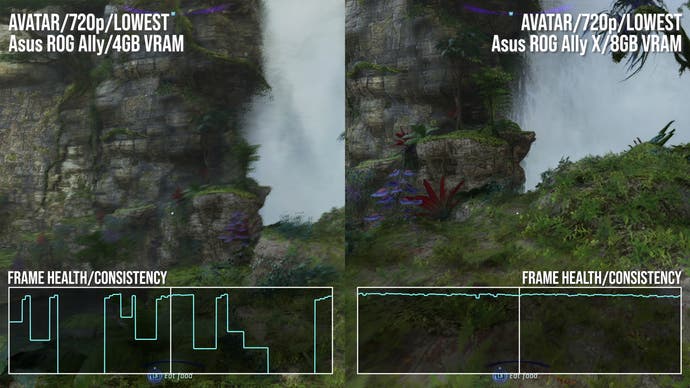Asus not too long ago introduced the ROG Ally X – a refresh of final yr’s Ally. It has been criticised for not providing any type of efficiency improve, however primarily based on my experiences testing a spread of PC Home windows handhelds, I feel it is a strong improve in some ways. The transfer from 16GB to 24GB of reminiscence addresses points afflicting a small however rising variety of new video games, whereas doubling the scale of the battery goes a great distance in checking out the primary downside impacting each Home windows handheld: the terrible battery life.
It is true although, the Asus ROG Ally X is utilizing the identical Z1 Excessive processor because the non-X mannequin. The octo-core Zen 4 CPU set-up paired with a 12 CU RDNA 3 GPU stays as is, working on the identical clock speeds. There’s a small efficiency enchancment although, because of the truth that the Ally X would not simply improve reminiscence capability, however bandwidth as properly. The 16GB of 6400MT/s LPDDR5 is changed with 24GB of 7500MT/s LPDDRX. These processors thrive on bandwidth, as we noticed with Steam Deck OLED, the place I noticed something from a two % to 9 % efficiency improve in video games from that sooner RAM – with out going into specifics within the preview section, it is best to count on a lot the identical within the transition from Ally to Ally X.
There are additionally eventualities the place having extra reminiscence affords up a huge enchancment in gaming efficiency – I refer you to Avatar: Frontiers of Pandora, which is a stuttering mess on the unique Asus ROG Ally, however is nigh-on stutter free on the Ally X. It’s because the sport requires an honest quantity of each system reminiscence and video RAM and whereas this may be configured within the Asus Armory Crate software program, no choice affords up a suitable gameplay expertise. The Ally X simply runs completely fantastic as is on its default setting, which splits the 24GB of RAM into 16GB of system reminiscence and 8GB of VRAM.
Asus ROG Ally
Asus ROG Ally X
Predominant Processor
AMD Z1 Excessive
AMD Z1 Excessive
Reminiscence
16GB LPDDR5 6400MT/s
24GB LPDDR5X 7500MT/s
Show
1920×1080 – 120Hz IPS with VRR
1920×1080 – 120Hz IPS with VRR
Battery
40WHr
80WHr
I/O
One USB-C, MicroSD, Headphone Jack, XG Cellular Port
Two USB-C (inc. one USB 4/Thunderbolt 4 Appropriate), MicroSD, Headphone Jack
One other instance is Treatment’s Alan Wake 2. It will possibly run on the unique Ally, however reminiscence checks on boot counsel that the sport requires 12GB of system RAM and 6GB of VRAM – an 18GB whole not accessible on the older mannequin. You’ll be able to ignore the prompts and plough on, however it’s hardly ultimate. This will likely appear barely odd in a world the place the Ally has the identical quantity of reminiscence as Xbox Sequence X and PS5 (extra the truth is, taking into account that the consoles reserve RAM for system duties), however the cut up reminiscence pool set-up on PC is a limiting issue – one thing that Ally X powers previous because of extra capability.
Past the reminiscence, there are additional enhancements and I would say that barring the inclusion of an OLED show or a large 8.8-inch display screen just like the Lenovo Legion Go, these adjustments put the Ally X up there with one of the best of the handhelds on the market.
First up, let’s discuss battery life. For me, that is by far and away the weakest part of the unique Ally with its 40Whr battery. The factor is, to get probably the most out of the Z1 Excessive, 25W consumption on the APU is the candy spot. Add on different system elements and also you’re energy consumption properly north of 40 watts. It’s totally, very straightforward to see battery life on the unique Ally consumed inside an hour – or much less. Whereas doubling the battery measurement is not going to provide you Steam Deck OLED-like longevity, round two hours of triple-A gaming (or a bit much less) utilizing the 25W APU energy setting is not that dangerous. It labored for me.
Handle cookie settings
The larger battery permits Asus the change to revamp the hand-held’s innards. The change from a white casing to a black one is apparent, however within the hand, it is the load that is most noticeable. At 678g, it is meatier than the unique Ally’s very slight 608g – however that is a worth I would simply pay for such a large battery. In any other case, the essential type issue of the machine stays largely unchanged – and that is a little bit of a marvel really. The AyaNeo Kun, for instance, has a barely smaller battery than the Ally X, however it’s clearly a a lot bigger unit and it weighs a whopping 900g – 222g extra.
Contained in the case, the brand new battery sees Asus revamping the internals considerably. The followers are smaller – which generally means louder – and but the brand new Ally has a claimed improve of as much as 24 % on airflow, whereas really being quieter. All I can actually say from a person perspective is that the 25W mode I like to make use of is unquestionably quieter than the unique Ally. The inner redesign implies that the smaller, Steam Deck-like 2230-format SSD offers approach to a extra normal 2280, opening the door to extra drives, cheaper drives and entry to larger capacities – all the best way as much as 8GB. We’re additionally getting a 1TB SSD now, elevated over the 512GB within the unique Ally which at all times felt very restrictive to me.
Going again to the outside, there’s extra weight to the analogue sticks, greater triggers and extra journey on the face buttons. There’s grippier grips too. These are smaller refinements and I did not actually have any points with any of these things on the usual Ally, however it’s all welcome nonetheless.

The ports state of affairs has modified and for the higher, The contentious SD card port – which brought on a bunch of issues for customers of the unique Ally – is moved to a very completely different location, as has the headphones socket. The only USB-C on final yr’s mannequin, mounted flush with an XG Cellular eGPU connector, can also be revised on Ally X. There at the moment are two USB-C ports, one in all which is USB-4 appropriate, that means you have got entry to a wider vary of eGPU choices or, merely extra I/O – at all times a little bit of a hassle spot on the unique Ally.
For a lot of although, this would possibly not be the hand-held they’ve been ready for. No considerable efficiency improve over final yr’s mannequin implies that the Asus ROG Ally X usually affords the identical gameplay expertise because the Lenovo Legion Go and the huge vary of Chinese language model handhelds on the market, primarily based on both the Z1 Excessive or the very comparable Ryzen 7 7840 or 8840U. Additionally, it nonetheless has the identical 7-inch 1080p LCD when OLED can be so a lot better. Nevertheless, it stays the one handheld with variable refresh price assist – and that is a gold mine as you possibly can depend on extra constant, clean gameplay with out having to lock to the refresh price or clear dividers of that refresh price (30fps at 60Hz, 40fps at 120Hz and many others). VRR is price its weight in gold.
It’s a little bit of a disgrace that the worth has been bumped to $799 thoughts you – and that is a fats pile of money taking into account how a lot Asus ROG Ally discounting we have seen over the previous yr. Nevertheless, with that being mentioned, we’re nonetheless a price-point that is considerably cheaper than the premium handhelds on the market with 32GB of reminiscence. I do not assume that the Asus ROG Ally X is the definitive Home windows PC transportable, however of all of the equal handhelds I’ve examined to this point, that is the one I would be packing in my journey bag primarily based on my testing to this point.















